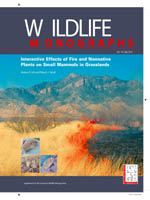Invasions by nonnative plants have changed the structure of many terrestrial ecosystems and altered important ecological processes such as fire, the dominant driver in grassland ecosystems. Reestablishing fire has been proposed as a mechanism to restore dominance of native plants in grasslands invaded by nonnative plants, yet fire may function differently in these altered systems, potentially affecting animals in novel ways. To assess whether invasions by nonnative plants alter the effects of fire on animals, we performed a manipulative experiment in semi-desert grasslands of southeastern Arizona that have been invaded by a perennial, nonnative grass from Africa, Lehmann lovegrass (Eragrostis lehmanniana). We applied fire to 36 of 54 1-ha plots established along an invasion gradient where dominance of E. lehmanniana ranged from 0% to 91% of total live plant biomass. Over the 5-year period from 2000 to 2004, we used mark-recapture methods to assess how population and community attributes of small mammals varied along the gradient of nonnative grass and in response to fire. We quantified changes in presence of 17 species, abundance of 9 species, total abundance of all species combined, species richness, and species composition. Based on 11,226 individual mammals from 24 species, we found that effects of nonnative-grass dominance varied with habitat preferences of each species, resulting in composition of the small-mammal community changing predictably along the invasion gradient. As dominance of nonnative grass increased, presence and abundance of granivorous heteromyids and insectivores (e.g., Chaetodipus, Perognathus, Onychomys; pocket mice and grasshopper mice) decreased, whereas presence and abundance of omnivorous and herbivorous murids (e.g., Reithrodontomys, Sigmodon; harvest mice and cotton rats) increased. Species richness of the small-mammal community averaged 8.4 species per plot and was highest at intermediate levels of nonnative-grass dominance where vegetation heterogeneity was greatest. Abundance of all small mammals combined averaged 26.9 individuals per plot and did not vary appreciably with nonnative-grass dominance. During the 4- to 8-week period immediately after fire, abundance of 6 of the 9 most common species changed, with 5 species decreasing and 1 species increasing on burned plots relative to unburned plots. During this same time period, species richness of small mammals decreased by an average of 3 species (38%) and total abundance of all species combined decreased by an average of 16 individuals (61%) on burned plots relative to unburned plots. Effects of fire on vegetation biomass, on presence of 9 of 17 mammalian species, and on abundance of 4 of 9 mammalian species remained evident ≥2 years after fire. Effects of fire on most small-mammal species varied with the degree of nonnative-grass dominance, suggesting that fire functioned differently 0n areas invaded by nonnative plants relative to areas dominated by native plants. Specifically, effects of fire on presence of 12 of 14 species and abundance of 7 of 9 species varied along the gradient of E. lehmaniana. During this post-fire period, however, composition of the small-mammal community in areas dominated by nonnative grass transitioned towards composition of areas dominated by native grasses, suggesting that fires had some restorative effect on habitat for small mammals. The relative strength of this effect will likely depend in general on the structural and compositional contrasts between invaded and native plant communities. Despite the reported ineffectiveness of fire at reducing dominance of nonnative plants, restoring fire to grasslands invaded by nonnative plants can help maintain the mosaic of vegetation conditions necessary to support the diverse assemblage of animals that inhabit these fire-governed ecosystems.
How to translate text using browser tools
1 May 2011
Interactive Effects of Fire and Nonnative Plants on Small Mammals in Grasslands
Andrea R. Litt,
Robert J. Steidl
ACCESS THE FULL ARTICLE
It is not available for individual sale.
This article is only available to subscribers.
It is not available for individual sale.
It is not available for individual sale.

Wildlife Monographs
Vol. 176 • No. 1
May 2011
Vol. 176 • No. 1
May 2011
Community composition
Eragrostis lehmanniana
fire
gradient
grasslands
heterogeneity
invasion




